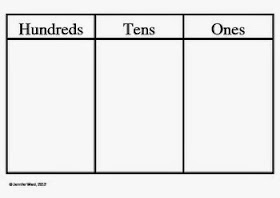Let me just start everyone off with a warning, I am definitely one of those people who went into Speech-Language Pathology precisely because I'm not a huge fan of math. I love chronological age calculators (any calculator really), tally marks, and simple percentages.
So, without further adieu, welcome to a brief crash course introduction to Common Core Math through the eyes of an SLP.
There are lots of blocks and they go everywhere. (I recommend walking very carefully.)
These lovely blue (and sometimes wooden) blocks are base ten pieces. I admit that I do like these little blocks as they are a great visual and tactile cue. My students don't have to draw a million circles, sticks, dots, squares, count all their fingers and toes, etc to count out each number. They just grab X of whatever manipulative that represents that placement. What I don't like are the names for these blocks. "Blocks" (thousands), "flats" (hundreds), "skinnies/rods" (tens), and "bits" (ones)....even if it does sort of describe the way they look. Mostly, I find it frustrating because I have to call them one name here and another name there. It's confusing for me and I'd imagine that the students get confused too. Consistency is key.
They also get to learn how to draw this really spiffy chart to use with the base ten pieces. They can write the number and then draw it in base ten form to solve equations. It's another great visual. The only bad part is when the students have to take all of this stuff and turn it into "expanded/extended form".
To me, writing in expanded form is basically writing what you put in the graphic organizer again. Some students get really frustrated with having to write all of this out as they know it's already there. They may even glare daggers at you.
And, "carrying over/regrouping"....The more I think about it, the less I want to say about this particular topic.
To me, writing in expanded form is basically writing what you put in the graphic organizer again. Some students get really frustrated with having to write all of this out as they know it's already there. They may even glare daggers at you.
And, "carrying over/regrouping"....The more I think about it, the less I want to say about this particular topic.
Math is a great time to work on following directions, initiating interactions and responding, and vocabulary. It just takes time, a dash of ingenuity, and very patient teachers who can put up with a million questions after their students go home. (And, my favorite lessons are the ones that involve least and greatest.)






No comments:
Post a Comment